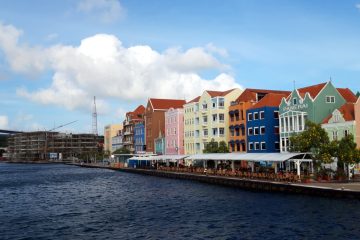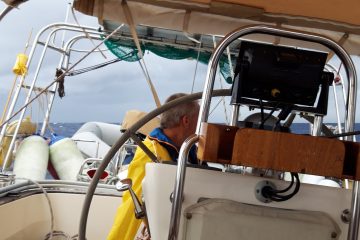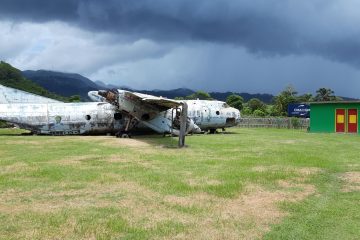At the beginning of March we sailed from St. Pierre (Martinique) in good weather to IÎles des Saintes (or simply Les Saintes) to pick up some friends from Hamburg – Chris & Harald. They were flying to Pointe-à-Pitre, Guadeloupe.
Guadeloupe is located about 65 nm (nautical miles) north of Dominica and a number of smaller islands belong to the French overseas territory such as Îles des Saintes, Marie Galante, La Désirade and Îles de la petit Terre.
The sail from Les Saintes to Guadeloupe was fast, windy and very squally. Squalls are noted for giving you scary wind and a lot of rain. The visibility in some of the squalls was low enough that we reduced sail and crept along until the squall passed.
Guadeloupe is densely populated with over 400,000 inhabitants. The outline of the island looks very similar to a butterfly and the two halves are absolutely opposite. One half, Basse-Terre, is covered with tropical rain forest, very mountainous and is topped by the active volcano, Soufriere, at 1467 meters. The other half, Grande-Terre, is flat and relatively dry.
After the arrival of our guests we sailed to Marie Galante. This sailing day was anything but relaxing for our guests. We had one squall after the other, it was raining cats and dogs and the wave height was 2m or more. After about 4 hours we anchored in St. Louis Bay and were glad to finally be there.
Marie Galante is very low and relatively dry. The island is known for its exquisite rum, so of course we had to visit a rum distillery. It also offers beautiful white beaches both in the north and in the south.
We explored the island by car which can be done in one day.
We anchored for two days in very shallow water in the bay Anse Canot, which was a dream. However, on the 2nd evening we had an invasion of flying ants on board so we had to close everything.
Slowly the weather improved and after a couple of days we had a nice sailing day to the Les Saintes.
The small island archipelago of the Les Saintes is only about 15 nm west of Marie Galante.
The small islands are picturesque and the little town is beautiful, if you ignore the fact that every day a ferry from Guadeloupe brings hundreds of day tourists there.
We did several short walks and found iguanas, which were sometimes sitting quite calmly on the road, or occasionally up a tree!
From there we had a leisurely sail on to Guadeloupe and anchored at Basse-Terre. We wanted to climb the Soufriere volcano the next day. The hike up the volcano was great and we were very lucky with the weather because it is not often that the volcano is cloudless. We were amazed with the number of locals who were also climbing the volcano. It’s not a difficult walk, but it can be very steep and sometimes slippy. On the summit it is permanently windy and can be very cold.
Back on the boat we sailed on to Bouillante, this bay is known for its hot spring on the beach. The hot spring is actually the waste hot water from a geothermal energy plant in Bouillante which supplies a large part of the population on Basse-Terre. Already in our anchorage we noticed the significant difference in water temperature.
A short dinghy ride away and we were at the “spring” which empties directly into the sea. Every evening many locals meet at this spring and a bar just above makes it just perfect place to be in the water for a few hours.
The water from the spring comes with some force into the sea and you can easily get pushed about by it. The temperature varies according to where you stand (or swim) from cool to very pleasant, right up to very hot! A barrier prevents the public from getting too close to the hottest parts which could be dangerous.
It does get very full there, but there’s plenty of room. If not, a short walk will take you to the bar for a cold beer or “Planteur”.
Our friends gave us a farewell gift of a guided snorkeling trip to the Les îlets Pigeon, more commonly known as the Jacques Cousteau Underwater Reserve, located in front of Malendure beach
It was set up by Captain Jacques Cousteau and within the reserve area no boats are allowed to anchor. This is to preserve the corals and the general environment in the area. The snorkeling there was a great experience and at the end our helpful guide showed us several big Karet (or Luth) turtles. These eat the sea grass found on the sea floor and are one of the only turtles to have a soft or leathery shell.
Our pictures from the GoPro are a little disappointing and needed some colour correction to make them look OK. The problem is that you cannot see in the little screen on the GoPro what you are photographing.
Our friends left and we sailed north to Dehaies in order to checkout of Antigua (done in a bar!!). The few days stay on anchor there was very windy, but we had been warned.
We then sailed the 45 nm north from Dehaies to Jolly Bay, Antigua (passing Montserrat and its volcano on the way) Our Italian friends were already waiting for us in Jolly Bay.
This is a great anchorage that became gradually shallower and shallower. Finally our depth gauge showed -0.1m (yes – minus depth!) under the keel. In reality there is a 0.5m safety margin under the keel but that’s not much with tide and swell. Everywhere were turquoise waters and white sandy beaches. Our Italian friends welcomed us again with a great meal which of course Freddy the gourmet chef had prepared.
We spent a great week in Antigua, explored the small island with the local buses and even went lobster fishing (alas, the lobsters were smarter than us). The capital St. John’s is colourfully loud and offers much Caribbean flair.
On the south end of the island is the famous “Nelsons’ Dockyard” and Falmouth harbour. There are marinas in both places but this really is the realm of the super rich. We have never seen such large sailing boats – many of them in excess of 40m long.
Nelson’s Dockyard has an interesting history but seems to be more geared up for tourists than anything else now. Around the area there is nothing – no town or anything. Just a small village at Falmouth harbour and a few bus stops. Lord Nelson wouldn’t recognise it now…
The island state of Antigua is independent but everywhere you can still find evidence of the colonial past. The people are very friendly and happy if you are interested in the history of their origin.



